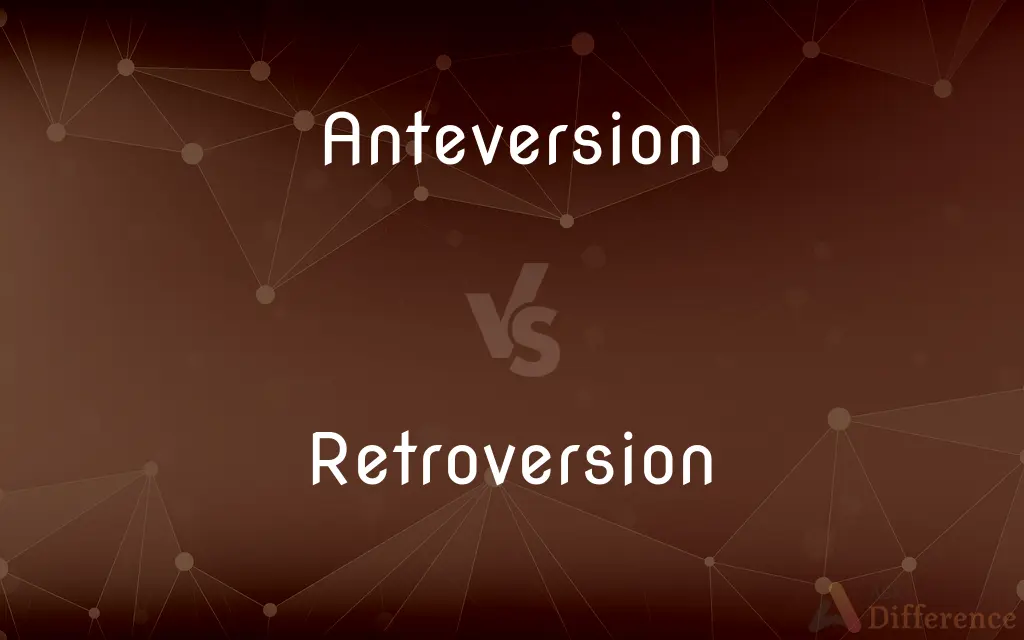Anteversion vs. Retroversion — What's the Difference?
By Maham Liaqat & Fiza Rafique — Updated on April 8, 2024
Anteversion refers to a forward tilt of an organ, while retroversion describes its backward tilt.

Difference Between Anteversion and Retroversion
Table of Contents
ADVERTISEMENT
Key Differences
Anteversion and retroversion are terms often used in medical contexts, particularly relating to the positioning of anatomical structures. Anteversion signifies a forward orientation or tilt of an organ or part of the body. In contrast, retroversion describes a backward tilt or orientation of an organ or part. Like anteversion, retroversion is commonly used to discuss the positioning of the uterus or hip joints, indicating a tilt away from the standard anatomical position.
While both terms define the orientation of body parts, their implications for health and function can differ significantly. Anteversion, for instance, in the context of the uterus, is considered a normal variation and typically does not result in health issues. However, excessive anteversion, especially in the hips, can affect posture and walking patterns. Conversely, retroversion, particularly of the uterus, may be associated with symptoms like back pain or difficulties in pregnancy, though it is also often a normal anatomical variation.
The diagnosis and clinical significance of anteversion and retroversion vary based on the organ involved and the degree of tilt. For the femur, for example, anteversion refers to the angle between the neck and shaft of the femur being greater than normal, potentially leading to inward turning of the legs. Retroversion, on the other hand, might contribute to outward turning of the legs. In the uterus, these positions can influence fertility, pregnancy, and the method of delivery, with certain degrees of tilt possibly necessitating medical intervention or monitoring.
Both anteversion and retroversion highlight the diversity of human anatomy and the importance of individualized medical assessment. While these conditions often do not cause problems, significant deviations from the norm may require specific treatments or adjustments to manage symptoms and maintain quality of life.
Comparison Chart
Definition
Forward tilt or orientation of an organ.
Backward tilt or orientation of an organ.
ADVERTISEMENT
Commonly Applied To
Uterus, femoral neck.
Uterus, femoral neck.
Health Implications
Often normal; excessive tilt can affect posture and gait.
May be associated with pain or reproductive issues; often a normal variation.
Clinical Significance
Depends on the degree of tilt; generally less concerning if within normal limits.
Can be a normal variation; significant retroversion might require monitoring or intervention.
Example
A femoral neck with increased anteversion can lead to inward turning of the legs.
A retroverted uterus may be associated with back pain or difficulty in pregnancy.
Compare with Definitions
Anteversion
A forward tilt of an anatomical structure.
Femoral anteversion can cause a child to walk with a pigeon-toed gait.
Retroversion
Orientation of an organ away from the usual forward-facing position.
Femoral retroversion can lead to an out-toeing walking pattern.
Anteversion
A condition where the angle of an organ is forward relative to the body's midline.
Hip anteversion affects the alignment and function of the hip joint.
Retroversion
A medical term indicating the backward position of body parts.
Retroversion in the shoulder joint can affect throwing mechanics in athletes.
Anteversion
The normal positioning or tilt of an organ, typically not causing symptoms.
Anteversion in the uterus does not usually affect fertility.
Retroversion
An anatomical variation that might require monitoring in certain medical contexts.
Uterine retroversion is monitored in pregnancy for potential complications.
Anteversion
Orientation of an organ towards the front of the body.
Uterine anteversion is considered the usual position in most women.
Retroversion
A backward tilt of an anatomical structure.
A retroverted uterus may tilt towards the spine instead of the bladder.
Anteversion
A medical term describing the forward-facing position of body parts.
Anteversion of the femoral neck is measured to assess hip alignment.
Retroversion
A turning or tilting backward.
Anteversion
(medicine) The state or condition of being anteverted.
Retroversion
The state of being turned or tilted back.
Anteversion
A displacement of an organ, esp. of the uterus, in such manner that its whole axis is directed further forward than usual.
Retroversion
A turning or falling back.
Retroversion
(medicine) The state or condition of being retroverted.
Retroversion
A turning or bending backward; also, the state of being turned or bent backward; displacement backwards; as, retroversion of the uterus.
Retroversion
A turning or tilting backward of an organ or body part;
Retroversion of the uterus
Retroversion
Translation back into the original language;
The teacher translated Latin texts into English which he gave to his students for retroversion
Retroversion
Returning to a former state
Common Curiosities
Can anteversion or retroversion affect pregnancy?
Yes, particularly uterine position can influence pregnancy outcomes, but many women with these conditions experience normal pregnancies and deliveries.
Are anteversion and retroversion treatable?
While often no treatment is necessary, specific exercises, physical therapy, or, in rare cases, surgery might be recommended to manage symptoms or correct significant anatomical deviations.
What does retroversion mean?
Retroversion describes a backward tilt or orientation of an organ, indicating a variation from the standard anatomical position.
What is anteversion?
Anteversion refers to the forward tilt or orientation of an anatomical structure, commonly assessed in organs like the uterus and hip joints.
Can anteversion affect walking?
Yes, especially femoral anteversion can affect gait patterns, leading to inward turning of the feet.
How are anteversion and retroversion diagnosed?
These conditions are typically diagnosed through physical examinations and imaging studies, such as X-rays, MRIs, or ultrasounds, depending on the organ involved.
Do anteversion and retroversion cause pain?
Not necessarily, but significant deviations from normal angles in structures like the hips can lead to discomfort or functional issues.
Is a retroverted uterus common?
Yes, a retroverted uterus is a common anatomical variation and does not usually lead to health problems.
Can posture be affected by these conditions?
Yes, the alignment of the hips and spine can be influenced by anteversion or retroversion, affecting overall posture.
Can retroversion be corrected?
In many cases, retroversion does not require correction. When symptomatic, physical therapy or corrective surgeries are options, depending on the severity and the affected structure.
What's the difference between anteversion and anteflexion?
Anteversion refers to a forward tilt of an entire organ or structure, while anteflexion describes a bending forward, often used in relation to specific parts of an organ.
Are these conditions genetic?
The predisposition to anteversion or retroversion can be genetic, affecting the development of skeletal structures.
Is there a link between hip anteversion and osteoarthritis?
Abnormal angles of anteversion or retroversion may contribute to abnormal wear and tear on the joints, potentially increasing the risk of osteoarthritis.
How do these conditions affect athletes?
Athletes with significant anteversion or retroversion might require specialized training adjustments to optimize performance and prevent injuries.
Share Your Discovery

Previous Comparison
Row vs. Street
Next Comparison
Detrimental vs. HarmfulAuthor Spotlight
Written by
Maham LiaqatCo-written by
Fiza RafiqueFiza Rafique is a skilled content writer at AskDifference.com, where she meticulously refines and enhances written pieces. Drawing from her vast editorial expertise, Fiza ensures clarity, accuracy, and precision in every article. Passionate about language, she continually seeks to elevate the quality of content for readers worldwide.
















































